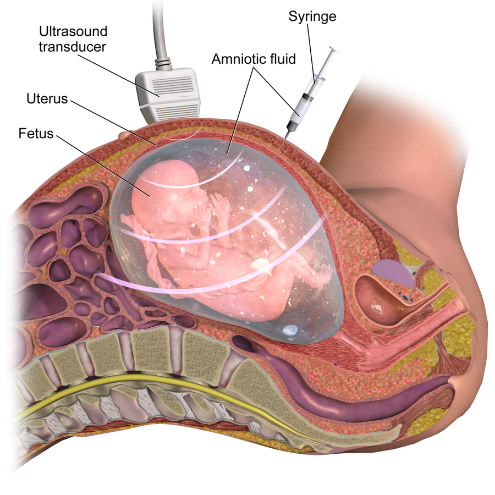
The permissible use of the technique amniocentesis is for
(A) Detecting any genetic abnormality
(B) Detecting sex of the unborn foetus
(C) Artificial insemination
(D) Transfer of embryo into the uterus of a surrogate mother
Answer
480k+ views
Hint: Amniocentesis is a procedure in which amniotic fluid is removed from the uterus for testing or treatment. Amniotic fluid is the fluid that surrounds and protects a baby during pregnancy. There are varied uses of the technique amniocentesis and it depends on the respective country to permit its significance accordingly.
Complete answer: By the name indicates, amniocentesis refers to the procedure in which amniotic fluid is removed from the uterus for testing or treatment. Amniotic fluid is the fluid that surrounds and protects the foetus during pregnancy. It contains cells of the foetus and various proteins. There are various applications of this technique but it depends on the respective country to permit its significance. The permissible use of amniocentesis is for genetic testing, foetal lung testing, diagnosis of foetal infection, and paternity testing. It can also be used to determine the gender or sex of the unborn foetus. But it is legally banned in countries like India in order to prevent female foeticides.

Understanding the options one by one,
Option (A) Detecting any genetic abnormality: The important application of amniocentesis is detecting the presence of a genetic abnormality in the foetus such as Down syndrome and it’s permissible. Therefore, this is the correct answer.
Option (B) Detecting the sex of the unborn foetus: This is one of the uses of amniocentesis but detecting the sex of the unborn foetus is not permitted in countries like India. Hence, this is not the correct answer.
Option (C) Artificial insemination: This is a technique where the semen collected either from the husband or a healthy donor is artificially introduced either into the vagina or uterus of the female. This technique is nowhere related to amniocentesis and hence, this is not the correct answer.
Option (D) Transfer of embryo into the uterus of a surrogate mother: It refers to assisted reproductive technologies (ART) and hence, this is not the correct answer.
Therefore, Option (A) is correct.
Note: It is essential to know the permissible use of amniocentesis which includes genetic testing, foetal lung testing, paternity testing, and diagnosis of foetal infection. One should know that it is illegal only in India to detect the sex of an unborn foetus through amniocentesis, but, it is permitted in developed countries.
Complete answer: By the name indicates, amniocentesis refers to the procedure in which amniotic fluid is removed from the uterus for testing or treatment. Amniotic fluid is the fluid that surrounds and protects the foetus during pregnancy. It contains cells of the foetus and various proteins. There are various applications of this technique but it depends on the respective country to permit its significance. The permissible use of amniocentesis is for genetic testing, foetal lung testing, diagnosis of foetal infection, and paternity testing. It can also be used to determine the gender or sex of the unborn foetus. But it is legally banned in countries like India in order to prevent female foeticides.

Understanding the options one by one,
Option (A) Detecting any genetic abnormality: The important application of amniocentesis is detecting the presence of a genetic abnormality in the foetus such as Down syndrome and it’s permissible. Therefore, this is the correct answer.
Option (B) Detecting the sex of the unborn foetus: This is one of the uses of amniocentesis but detecting the sex of the unborn foetus is not permitted in countries like India. Hence, this is not the correct answer.
Option (C) Artificial insemination: This is a technique where the semen collected either from the husband or a healthy donor is artificially introduced either into the vagina or uterus of the female. This technique is nowhere related to amniocentesis and hence, this is not the correct answer.
Option (D) Transfer of embryo into the uterus of a surrogate mother: It refers to assisted reproductive technologies (ART) and hence, this is not the correct answer.
Therefore, Option (A) is correct.
Note: It is essential to know the permissible use of amniocentesis which includes genetic testing, foetal lung testing, paternity testing, and diagnosis of foetal infection. One should know that it is illegal only in India to detect the sex of an unborn foetus through amniocentesis, but, it is permitted in developed countries.
Recently Updated Pages
Master Class 10 Science: Engaging Questions & Answers for Success

Master Class 10 Social Science: Engaging Questions & Answers for Success

Master Class 10 Maths: Engaging Questions & Answers for Success

Master Class 10 English: Engaging Questions & Answers for Success

Class 10 Question and Answer - Your Ultimate Solutions Guide

Master Class 9 General Knowledge: Engaging Questions & Answers for Success

Trending doubts
Give 10 examples of unisexual and bisexual flowers

Draw a labelled sketch of the human eye class 12 physics CBSE

Differentiate between homogeneous and heterogeneous class 12 chemistry CBSE

Differentiate between insitu conservation and exsitu class 12 biology CBSE

What are the major means of transport Explain each class 12 social science CBSE

What is the difference between resemblance and sem class 12 social science CBSE




